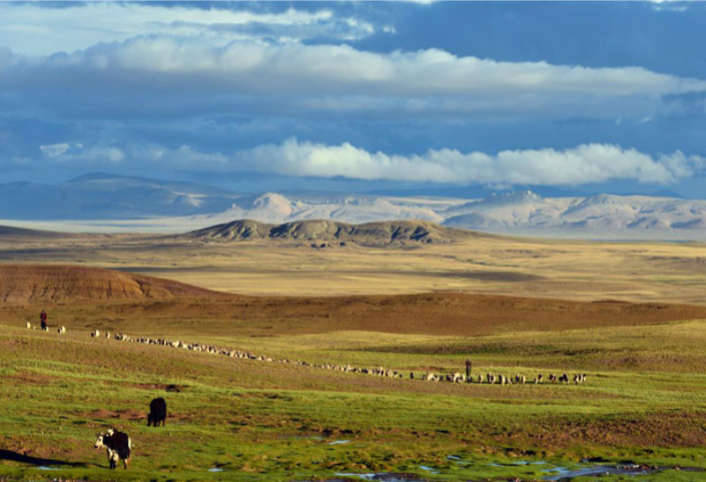‘Roof of the World’, Or Tibetan Plateau, Rose To Current Height More Recently Than Thought

“The Tibetan Plateau”; Image Courtesy: Science News. Image for representational use only.
Many million years ago, the Indian plate rammed with the Eurasian plates, pushing the land between them upward. The Himalayan mountain range was born and the Tibetan Plateau situated towards north of the mountains was pushed upward. The events were so impactful that it not only changed the topography of southern Asia, but also reshaped regional and even global atmospheric circulation and climate. But the topographic evolution and paleoclimatic history of the Qinghai-Tibetan Plateau (QTP) is poorly understood.
In this context, two recent researches published in Science have opened up new avenues in rewriting the history of the ‘roof of the world’. The one conducted by a team led by Svetlana Botsyun of Tubingen University, Germany, says that the chemical evidences found in the rocks of the plateau hint towards a fact — that the uplift event couldn’t have happened before about 40 million years ago. Although previous researches also suggested that the uplift event might have taken place more than 40 million years back, Svetlana’s team has put question marks on the previous estimation methods.
But interestingly, the other study, conducted by Tao Su of Chinese Academy of Sciences, China, and his team, suggests that the plateau was not a flat, windswept region as recently as 25 million years ago. Rather, the Tibetan Plateau was a diverse landscape consisting of steep mountains that surrounded deep valleys where palm trees could grow.
Clues To The Uplift Are Held In Traces Of Rains
Paleoaltimetry, one of the previous techniques that has been used to estimate how long the uplift of the plateau took, uses oxygen isotopes, forms of oxygen with same proton numbers but different masses. The higher elevations have a higher oxygen-16 to oxygen-18 ratio in the rainfall than in the lower elevations. Previous analyses of this ratio of oxygen isotopes preserved in minerals of carbonate rocks along with the age of the rocks suggested that the plateau got the elevation of more than 4 kilometers from the mean sea level more than 40 million years ago.
Another traditional way of estimating the age of the plateau is the use of plant fossils. The fossil evidence suggested that the plateau was much lower 40 million years ago.
Svetlana Botysun and her team took into account the fact that factors other than elevation can also affect oxygen isotopes — changes in carbon dioxide concentration and different water sources that becomes the precipitation can affect the ratios.
These factors played crucial roles during the Eocene Epoch, about 56 million to 34 million years ago. Svetlana Botysun’s team considered these factors in their computer simulation to recreate the atmospheric conditions during the Eocene Epoch. Though Botysun expressed apprehension about the precise time of the uplift, her team’s results showed that 40 million years ago, the Tibetan Plateau was not higher than 3 kilometers from the mean sea level.
The Palm Fossil And New Directions In Understanding The Tibetan Plateau’s Reality
The team led by Tao Su of China reported a fossil of a kind of palm tree found in Tibet. Their estimation says that the palm tree was not older than 25 million years. The ability of the plant to tolerate cold along with the plant’s living relatives—all tropical and subtropical species—made the researchers conclude that the Tibetan Plateau couldn’t have been more than 2.3 kilometers above the mean sea level.
The researchers suggest that the region was not a high, flat plateau at that time, instead, it consisted of deep valleys with mountains surrounding them and the palm plant of the fossil also lived in such a valley.
Robert Spicer, a co-author of the study, was quoted as saying—“What we think of as the Tibetan Plateau was actually a jigsaw of tectonic blocks of land, each with its own elevation history. That history began around 200 million years ago, during a previous tectonic collision with the Asian plate. By the time the Indian subcontinent began its collision, parts of what is now the plateau were already as high as 4.5 kilometers above sea level.”
The valley that the palm tree lived in, according to the researchers, was home to a fascinatingly diverse ecosystem. This was 60 million to 20 million years back. But as the Indian plate continued to collide with the Eurasian plate, the land continued to rise and the sediments eroded from the mountains eventually settled in the valley, thus forming a high and flat plateau.
Basically, both the researches agree on a key point — that what is now the Tibetan Plateau, rose to its current height much later than previously thought
Get the latest reports & analysis with people's perspective on Protests, movements & deep analytical videos, discussions of the current affairs in your Telegram app. Subscribe to NewsClick's Telegram channel & get Real-Time updates on stories, as they get published on our website.














